Kingdom of Nabatea › Amarna » Ancient origins
Articles and Definitions › Contents
- Kingdom of Nabatea › Who Was
- Amarna › Antique Origins
Ancient civilizations › Historical and archaeological sites
Kingdom of Nabatea › Who Was
Definition and Origins
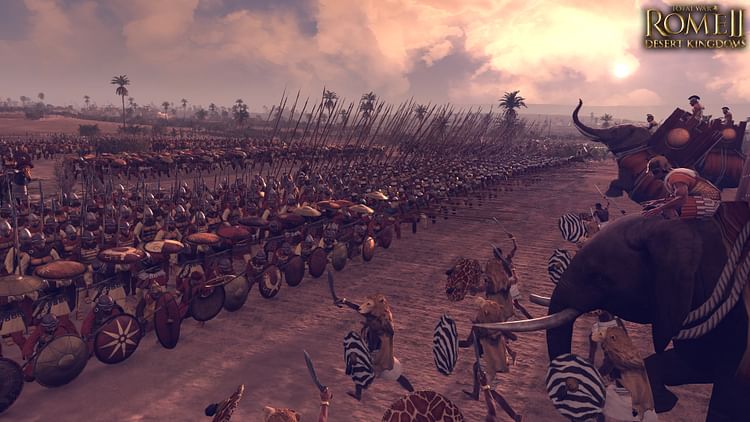
The Nabatean Kingdom was a powerful political entity which flourished in the region of modern-day Jordan between the 4th century BCE and c. 106 CE and is best known today for the ruins of its capital city of Petra. Although it is clear that a wealthy community was thriving in the immediate vicinity of Petra by 312 BCE (attested to by the Greek expedition mounted against it), scholars usually date the Nabatean Kingdom from 168 BCE, the date of their first known king, to 106 CE when it was annexed by the Roman Empire under Trajan (98-117 CE).
Nabateans were Arabian nomads from the Negev Desert who amassed their wealth first as traders on the Incense Routes which wound from Qataban (in modern-day Yemen) through neighboring Saba (a powerful trade hub) and on toward Gaza on the Mediterranean Sea. Their constant travel on these routes intimately familiarized them with the area and their skill in finding, and preserving, sources of water enabled them to transport goods more quickly and efficiently than others.
The site of their city of Petra, carved from the sandstone cliffs of mountains and not easily accessible, would have been built after they were already wealthy from trade. Their decision to build in that particular area has mystified scholars and historians for centuries because there was no natural source of water there and the locale was far from hospitable. The location actually makes a great deal of sense, however, as their position at Petra allowed them to monitor the Incense Routes and tax caravans passing through their territory, thus enriching them further, and its inaccessibility provided protection.
Following annexation by Rome in 106 CE, Petra and other Nabatean cities such as Hegra steadily lost their hold over the Incense Routes and their control over the region generally. The rise of the Syrian city of Palmyra as a center of trade diverted caravans from the Nabatean cities which then declined in wealth and prestige. The emperor Aurelian ’s destruction of Palmyra c. 272 CE came too late to resuscitate the Nabatean economy, and by the time of the Arab Invasion of the 7th century CE, the Nabatean Kingdom had been forgotten.
EARLY TRADE ON THE INCENSE ROUTES
The term 'Incense Routes' refers to a number of different directions traders took between southern Arabia and the port of Gaza between the 7th/6th centuries BCE and the 2nd century CE. Trade along these routes seems to have become most lucrative c. 3rd century BCE by which time the Nabateans had control of the most important cities along the routes. The Incense Routes do not describe a single road or roads between Arabia and Gaza but a general direction merchants traveled between those two points. According to Pliny the Elder (23-79 CE), the routes encompassed 1,200 miles (1,931 km) and took 65 days to travel one way with a stopover at a city, ideally, every night.
THE CITIES CONTROLLED BY THE NABATEANS BY THE 3RD CENTURY BCE HAD BECOME SUCH AN INTEGRAL PART OF TRADE ALONG THE ROUTES THAT THEY COULD NOT BE AVOIDED.
These stops were not merely for rest but were an important aspect of business. The city of Mamshit, for example, was famous for their Arabian horses which commanded high prices. Merchants would therefore move from city to city, trading their goods at each stop before reaching the final destination of the port at Gaza. As certain cities began taxing merchants more heavily, trade would veer toward others which were considered more hospitable. The cities controlled by the Nabateans by the 3rd century BCE, however, had become such an integral part of trade along the routes that they could not be avoided.
Among these cities were those which would become known as Haluza, Mamshit, Avdat, and Shivta all of which offered goods for trade as well as comfortable accommodations for the traders. Nabatean forts erected along the routes guaranteed the safety of the merchants but, as with the tax they levied on traders, their protection came at a price. Although the Nabateans were already quite wealthy by the 3rd century BCE as traveling merchants, they became more so through their tight control of the Incense Routes once they had established their kingdom.
WEALTH, CUSTOMS, WOMEN'S RIGHTS
It is thought that they were able to become so successful through their early control of water along the routes. While other Arabian tribes had to barter for water, the Nabateans dug cisterns which filled with rainwater and then covered them and left signs which only they would recognize. Following this policy, they were able to travel with greater ease than their competition in trade. They were also able to solve the problem of water for Petra through technological ingenuity. The Nabateans orchestrated an elaborate system of water transportation and conservation which was unrivaled in its day and has not yet been surpassed in the region. The area is subject to flash floods, and through a careful construction of dams, cisterns, and aqueducts, the Nabateans were able to create an artificial oasis in an arid district which not only sustained them but elevated them to the most powerful kingdom in the region.
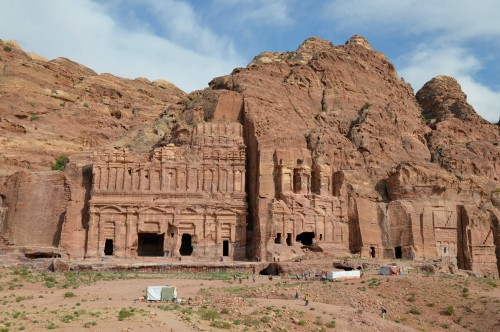
Nabataean Tombs of Petra
Precisely when cities like Petra and Hegra were constructed is unclear but they were well established by the later 4th century BCE when the wealth of the Nabateans attracted the attention of the Greek general (and future king) Antigonus I (r. 306-301 BCE). In 312 BCE, Antigonus pretended friendship with the Nabateans and then sent his son Demetrius in a surprise attack on Petra. The Nabateans had not been fooled, however, and were prepared for Demetrius. His offensive failed and he came to terms with the Nabateans and returned to his father; both were driven from the region by the Nabateans in a later engagement.
The immense wealth of the Nabatean Kingdom grew and became legendary in its own time. Centuries later, it was still mentioned by historians such as Strabo (died c. 23 CE) and Diodorus Siculus (1st century BCE). These two writers, as well as others, portray the Nabateans uniformly in a positive light. Diodorus addresses the wealth of the Nabateans, as well as their customs, in Book XIX of his Histories :
For the sake of those who do not know, it will be useful to state in some detail the customs of these Arabs, by following which, it is believed, they preserve their liberty. They live in the open air, claiming as native land a wilderness that has neither rivers nor abundant springs from which it is possible for a hostile army to obtain water.It is their custom neither to plant grain, set out any fruit-bearing tree, use wine, nor construct any house; and if anyone is found acting contrary to this, death is his penalty.They follow this custom because they believe that those who possess these things are, in order to retain the use of them, easily compelled by the powerful to do their bidding. Some of them raise camels, others sheep, pasturing them in the desert. While there are many Arabian tribes who use the desert as pasture, the Nabataeans far surpass the others in wealth although they are not much more than ten thousand in number; for not a few of them are accustomed to bring down to the sea frankincense and myrrh and the most valuable kinds of spices, which they procure from those who convey them from what is called Arabia Eudaemon [“Fortunate Arabia”, modern-day Yemen].They are exceptionally fond of freedom; and, whenever a strong force of enemies comes near, they take refuge in the desert, using this as a fortress; for it lacks water and cannot be crossed by others, but to them alone, since they have prepared subterranean reservoirs lined with stucco, it furnishes safety.As the earth in some places is clayey and in others is of soft stone, they make great excavations in it, the mouths of which they make very small, but by constantly increasing the width as they dig deeper, they finally make them of such size that each side has a length of one plethrum [101 ft/30 metres].After filling these reservoirs with rain water, they close the openings, making them even with the rest of the ground, and they leave signs that are known to themselves but are unrecognizable by others.They water their cattle every other day, so that, if they flee through waterless places, they may not need a continuous supply of water. They themselves use as food flesh and milk and those of the plants that grow from the ground which are suitable for this purpose; for among them there grow the pepper and plenty of the so‑called wild honey from trees, which they drink mixed with water. (XIX.94.2-10)
Strabo presents a similar picture of the Nabateans but contradicts Diodorus on the custom of drinking wine, claiming that they cultivated grapes for wine and drank at banquets. He does make the point, however, that they did not drink to excess like the Romans did but restricted themselves to no more than eleven cups in the course of an evening (Geography XVI.4.26). He further details how they used camels instead of horses, wore loincloths instead of tunics, and were so democratic that their king would insist on serving others at a banquet.
Women were considered equal to men in Nabatean culture. Inscriptions indicate that women were priestesses, co-rulers or autonomous monarchs, could inherit and dispose of property, owned their own tombs, brought lawsuits and represented themselves in court, and were depicted on coins. Some of the most popular deities in the Nabatean pantheon were female such as Al-'Uzza, Manawat, and Allat.
NABATEAN RELIGION
Nothing is known of the religious practices of the Nabateans except that they were polytheistic and worshiped the sun in ceremonies conducted on the tops of temples and honored their gods in private ceremonies in the home. There was a priestly class which was open to both men and women, but how one was chosen or what one's preparation for the priesthood may have been is unknown. It is likely that, as in Egypt, the priests and priestess tended to the gods, not the people, and there does not seem to be any institution of public worship services other than festivals.
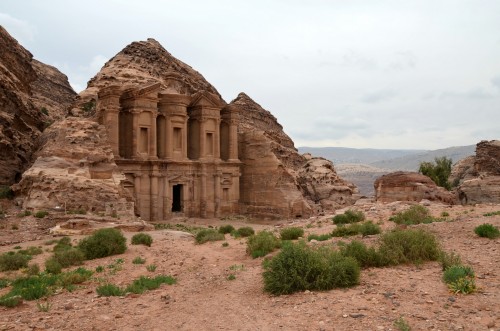
The Monastery in Petra
The gods of the Nabatean pantheon were never represented in full-scale statuary but appear carved into doorways, in the nooks of temples, on coins, tombs, ceramics, and as amulets and charms. The three most important gods in the early years of the culture were:
Al-Qaum - god of war, protector of the people, god of nighttime, protector of souls
Al-Kutby - god of knowledge, writing, and divination
Al'Uzza - supreme mother goddess, associated with divine and earthly power
Later deities were Manawat (goddess of fate and fertility), Allat (goddess of renewal, spring, and fertility), and Dushara (also given as Dushares, god of the mountains and daytime, associated with the sun). Of all these deities, Dushara endured the longest and was the deity worshiped from the rooftops of Nabatean temples. He was still represented on coinage following the annexation of Nabatea by Rome.
THE NABATEAN KINGS & CONFLICTS
The Nabateans were literate and developed the Arabic script but they wrote nothing of their own history. The story of their culture, customs, and kings was written by Greek and Roman writers and is suggested by their architecture, art, and brief inscriptions they left behind. As their kingdom developed, the Nabateans came into closer contact and conflict with those of the surrounding regions and their kings are mentioned increasingly by writers from those nations.
There was an early king possibly named Rekem or Raqmu for whom the city now known as Petra was named. Petra (from the Greek for “rock”) was the Greek name for the Nabatean capital of Raqmu. When this early king lived and reigned is as mysterious as the date when Petra was carved from the cliff sides. The first historically attested king is Aretas I (c. 168 BCE) and his reign marks the beginning of the Nabatean Kingdom.
Aretas I's date is attested by a Nabatean inscription citing 168 BCE and he is also mentioned in the biblical Book of II Maccabees (5:8) which confirms his reign at that time. He expanded the territory of Nabatea and was known as “the Tyrant of the Arabs” by his enemies. He supported the Maccabees of Judea in their struggle against the Seleucid Greeks (c.168/167-c.160 BCE) and allowed the forces of Judas Maccabeus to conduct raids from his territory.
The next Nabatean monarch - said to have succeeded Aretas I but most likely a later king - is known as Aretas II (also as Erotimus, rc 120/110-96 BCE). Aretas II came into conflict with the Hasmonean Dynasty installed by the Maccabees owing to the Judean policies of expansion. The Hasmonean king Alexander Janneus (r. 103-76 BCE) destroyed Gaza and took control of the terminus of the Incense Routes, infringing on Nabatean profits.
Aretas II's successor, Obodas I (c. 96-85 BCE) defeated Janneus in battle and reclaimed Gaza. He then defeated the Seleucid Greeks under Antiochus XII Dionysius (87-84 BCE), killing the king and scattering his army. After this victory, he was deified by his people as attested by a memorial at his grave in the city of Avdat. He was succeeded by his brother Rabbel I (c.85 BCE) who was killed in battle and the throne passed to another brother who took the throne name Aretas III (c. 85-60 BCE).
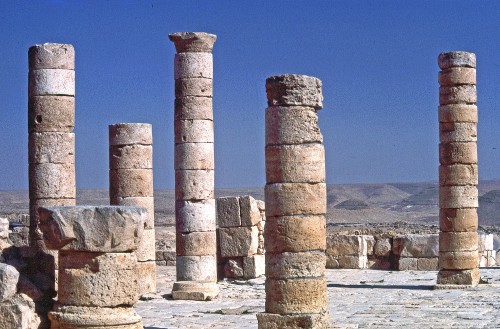
Avdat
Aretas III enlarged Nabatean territory to its greatest extent, controlling trade routes from Syria across Arabia toward the southern coast. In 64 BCE the Roman general Pompey invaded and took Syria for Rome and his general Scaurus was sent to take Petra. Scaurus had no more success than Demetrius had centuries before, but the Roman army was far more powerful than the earlier Greek forces, and the Nabateans were forced to pay tribute to Rome to retain their independence.
Aretas III was succeeded by Obodas II (c. 60-59 BCE) who died shortly after coming to power, and the throne passed to Malichus I (c. 59-30 BCE) who was forced to submit to Herod the Great as a vassal. He was succeeded by Obodas III (c. 30-9 BCE) who defended the Nabatean Kingdom against Rome primarily by sending his chief minister Syllaeus to “guide” the Roman army under Gallus toward Nabatean cities. Syllaeus pretended all along to be a sincere friend of the Romans and effortlessly led them astray. He was eventually executed at Rome for treachery.
Obodas III was succeeded by Aretas IV (c. 9 BCE- 40 CE) who is considered the greatest of the Nabatean kings. Nabatean inscriptions record his name as “Aretas, King of the Nabateans, lover of his people” and he was revered as a great monarch.His wife, Chuldu (also given as Huldu, Huldo) reigned with him and possibly on her own after his death. Aretas IV consolidated Nabatean power in the region, even in the face of Roman incursions, and was able to win recognition from Augustus Caesaras an autonomous king. Women's rights, arts, culture, law, and the Nabatean economy all reached their height under his reign.
He was succeeded by his son Malichus II (c. 40-70 CE) who lost territories to Rome and tried, unsuccessfully, to win Roman respect by sending Nabatean forces to help the Romans put down the Jewish Revolt against Roman rule in 66-70 CE. He died, or was killed, and was succeeded by Rabbel II Soter (c. 70-106 CE), known as the savior of his people even though he lost more territory to Rome and Nabatean prestige declined under his reign. He was briefly succeeded by his sister Gamilath, but the Nabatean Kingdom had run its course by this time as Rome grew in power, and the region as annexed as the Roman province of Arabia Petrea in 106 CE.
CONCLUSION
The cities of the Nabateans declined under Roman rule and an earthquake in c. 363 CE brought down many of them. The region was controlled by the Eastern Roman (Byzantine) Empire which established churches in the cities and revitalized commerce until another earthquake in c. 551 CE resulted in further widespread destruction. By the time of the Arab Invasion in the 7th century CE, the cities had long been deserted and the Nabateans forgotten.
It was only in the 19th century CE, when European explorers began to visit the area, that cities like Petra were rediscovered and the Nabatean culture attracted attention through the city of Petra. Interest in the Nabateans grew during the 20th century CE with a number of scholars and archaeologists visiting the region and excavating the ancient sites. Petra was declared a World Heritage Site in 1985 CE and chosen as one of the New Seven Wonders of the World in 2007 CE.
The Nabateans' skill in masonry, clearly evident in the extant structures of Petra, was unmatched in the ancient world, and their abilities to make the most out of any opportunity enabled them to become the wealthiest kingdom in the region. Although forgotten for centuries, the Nabateans are today recognized as a highly developed culture who were able not only to endure the harsh climate of the region but to thrive in it.
Amarna › Antique Origins
Definition and Origins
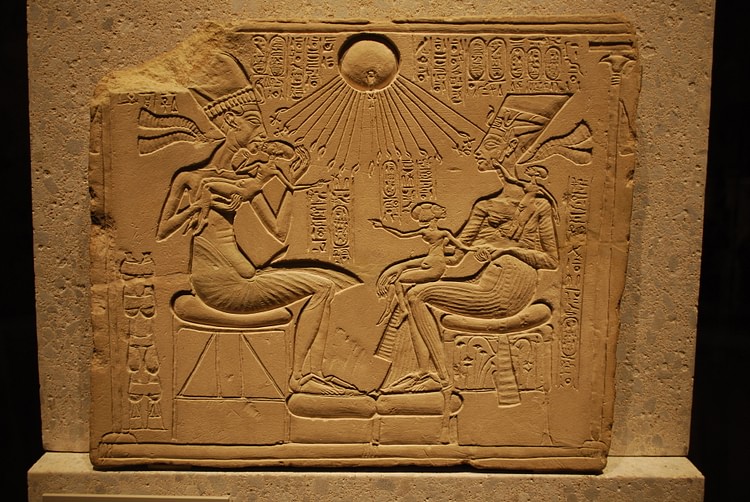
Amarna is the modern Arabic name for the site of the ancient Egyptian city of Akhetaten, capital of the country under the reign of Akhenaten (1353-1336 BCE). The site is officially known as Tell el-Amarna, so-named for the Beni Amran tribe who were living in the area when it was discovered.
A 'tell' in archaeology is a mound created by the remains of successive human habitation of an area over a given number of years. As each new generation builds on the ruins of the previous one, their buildings rise in elevation to create an artificial hill.Amarna differs from the usual 'tell' in that it did not fall to a foreign power or earthquake and was never built over in antiquity; it was instead destroyed by order of the pharaoh Horemheb (c. 1320-1292 BCE) who sought to erase Akhenaten's name and accomplishments from history; afterwards its ruins lay in the plain by the Nile River for centuries and gradually was built on by others who lived nearby.
When he came to power, Akhenaten was a powerful king entrusted – as all kings were – with the maintenance of ma'at(harmony and balance) in the land. Ma'at was the central value of the culture which allowed all aspects of life to function harmoniously as they should. It came into being at the beginning of creation and so, naturally, a king's observance and maintenance of ma'at relied heavily on the proper veneration of the gods through traditional rites and rituals.
AKHENATEN'S ONE TRUE GOD WAS LIGHT, THE LIGHT OF THE SUN, WHICH SUSTAINED ALL LIFE.
Although Akhenaten initially kept to this practice, in around the fifth year of his reign (c. 1348 BCE) he abolished the ancient Egyptian religion, closed the temples, and imposed his own monotheistic vision on the people. This innovation, though hailed by monotheists for the last hundred years, crippled the Egyptian economy (which relied heavily on the temples), distracted the king from foreign affairs, stagnated the military, and resulted in Egypt ’s significant loss of status among neighboring lands.
It is for these reasons that Akhenaten's son and successor, Tutankhamun (c. 1336-1327 BCE), returned Egypt to traditional religious practices and rejected the monotheism of his father. He did not live long enough to complete the restoration of Egypt, however, and so this was accomplished by Horemheb. This era in Egypt's history is known as the Amarna Period and is usually dated from Akhenaten's reforms to Horemheb's reign: c. 1348 - c. 1320 BCE.
THE CITY OF THE GOD
The god Akhenaten chose to replace all the others was not his own creation. Aten was a minor solar deity who personified the light of the sun. Egyptologist David P. Silverman points out how all Akhenaten did was elevate this god to the level of a supreme being and attribute to him the qualities once associated with Amun but without any of that god's personal characteristics. Silverman writes:
Unlike traditional deities, this god could not be depicted: the symbol of the sun disc with rays, dominating Amarna art, is nothing more than a large-scale version of the hieroglyph for 'light'. (128)
Akhenaten's one true god was light, the light of the sun, which sustained all life. Unlike the other gods, Aten was above human concerns and possessed no human weaknesses. As Akhenaten expresses in his Great Hymn to the Aten, his god could not be jealous or depressed or angry or act on impulse; he simply existed and, by that existence, caused all else to exist. A god this powerful and awe-inspiring could not be worshiped at any other god's repurposed temple nor even in any city which had known the worship of other deities; he required a new city built solely for his honor and adoration.
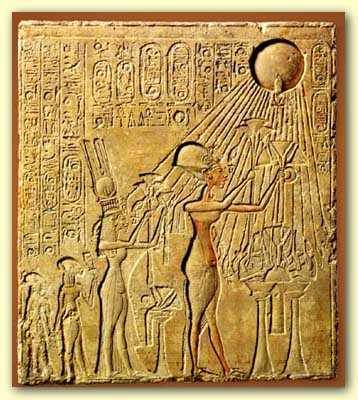
Akhenaten
This city was Akhetaten, built midway between the traditional capitals of Memphis in the north and Thebes in the south.Boundary steles were erected at intervals around its perimeter which told the story of its founding. On one, Akhenaten records the nature of the site he chose:
Behold, it is Pharaoh, who found it – not being the property of a god, not being the property of a goddess, not being the property of a male ruler, not being the property of a female ruler, and not being the property of any people. (Snape, 155)
Other stelae and inscriptions make clear that the foundation of the city was entirely Akhenaten's initiative as an individual, not as a king of Egypt. A pharaoh of the New Kingdom of Egypt (c. 1570 - c. 1069 BCE) would issue a commission for the building of a city or temple or erection of obelisks or monuments in his royal name and for the glory of his particular god, but these projects were to benefit the nation collectively, not just the king. Akhenaten's city was built for the sole purpose of providing him with an elaborate sacred precinct for his god.
DESIGN & LAYOUT
Akhetaten was laid out over six miles on the east bank of the Nile between the shore and the cliffs above Assiut. Some boundary stelae were carved directly into the cliffs with others free-standing on the far side of the city. The four main districts were the North City, Central City, Southern Suburbs, and Outskirts; none of these names were used to designate the locales in antiquity.
The North City was constructed around the Northern Palace where guests were received and Aten was worshiped. The royal family lived in apartments to the rear of the palace and the most opulent rooms, painted with outdoor scenes depicting the fertility of the Delta region, were dedicated to Aten who was thought to inhabit them. The palace had no roof – a common feature of the buildings at Akhetaten – as a gesture of welcome to Aten.

Amarna, Northern Palace
The Central City was designed around the Great Temple of Aten and the Small Temple of Aten. This was the bureaucratic center of the city where the administrators worked and lived. The Southern Suburbs was the residential district for the wealthy elite and featured large estates and monuments. The Outskirts were inhabited by the peasant farmers who worked the fields and on the tombs of the necropolis.
Akhenaten himself designed the city for his god, as his boundary stelae make clear, and refused suggestions or advice from anyone else, even his wife Nefertiti (c. 1370 - c. 1336 BCE). Precisely what kind of suggestions she may have made is unknown, but the fact that Akhenaten makes a point of stating that he did not listen to her advice would seem to indicate they were significant. Egyptologist Steven Snape comments:
It is obvious that the 'prospectus' for the new city carved on the boundary stelae is deeply concerned with describing the provision that will be made for the king, his immediate family, the god Aten, and those religious officials who were to be involved with the cult of the Aten. It is equally obvious that it utterly ignores the needs of the vast majority of the population of Amarna, people who would have been moved (possibly unwillingly) from their homes to inhabit the new city. (158)
Once Akhenaten moved his capital to Akhetaten, he focused his attention on the adoration of Aten and increasingly ignored affairs of state as well as the condition of the country outside of the city which was slipping into decline.
AKHENATEN'S REIGN & AMARNA LETTERS
The Amarna Letters are cuneiform tablets discovered at Akhetaten in 1887 CE by a local woman who was digging for fertilizer. They are the correspondence found between the kings of Egypt and those of foreign nations as well as official documents from the period. The majority of these letters demonstrate that Akhenaten was an able administrator when a situation interested him personally but also that as his reign progressed he cared less and less for the responsibilities of a monarch.
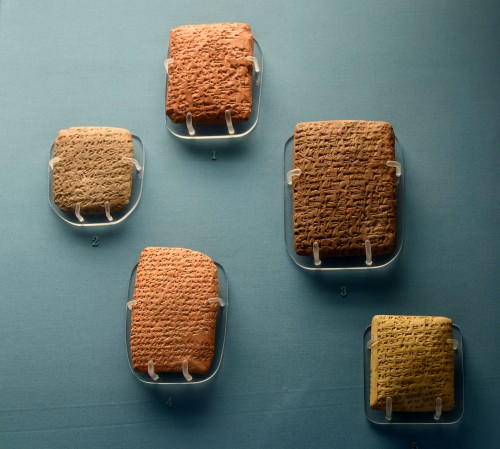
The Amarna Letters
There is no doubt that his attention to this problem served the interests of the state but, as other similar issues were ignored, it seems that he only chose to address issues which affected him personally. Akhenaten had Abdiashirta brought to Egypt and imprisoned for a year until Hittite advances in the north compelled his release but there seems a marked difference between his letters dealing with this situation and other king's correspondence on similar matters.
While there are examples like this one of Akhenaten looking after state affairs, there are more which provide evidence of his disregard for anything other than his religious reforms and life in the palace. It should be noted, however, that this is a point often – and hotly - debated among scholars in the modern day, as is the whole of the so-called Amarna Period of Akhenaten's rule. Regarding this, Dr. Zahi Hawass writes:
More has been written on this period in Egyptian history than any other and scholars have been known to come to blows, or at least to major episodes of impoliteness, over their conflicting opinions. (35)
The preponderance of the evidence, both from the Amarna letters and from Tutankhamun's later decree, as well as archaeological indications, strongly suggests that Akhenaten was a very poor ruler as far as his subjects and vassal states were concerned and his reign, in the words of Hawass, was "an inward-focused regime that had lost interest in its foreign policy" (45).
Akhenaten saw himself and his wife not just as servants of the gods but the incarnation of the light of Aten. The art of the period depicts the royal family as strangely elongated and narrow and, while this has been interpreted by some as "realism" it is far more likely symbolism. To Akhenaten, the god Aten was unlike any other – invisible, all-powerful, omniscient, and transformative – and the art from the period would seem to reflect this belief in the curiously tall and thin figures depicted: they have been transformed by the touch of Aten.
DESTRUCTION OF THE CITY
The city flourished until Akhenaten's death; afterwards, Tutankhamun moved the capital back to Memphis and then to Thebes.Tutankhamun initiated the measures to reverse his father's policies and return Egypt to the former beliefs and practices which had maintained the culture and helped it develop for almost 2,000 years. Temples were reopened, and the businesses which depended upon them were renewed.
Tutankhamun died before he could finish these reforms, and they were carried on by his successor, the former vizier Ay, and then by Horemheb. Horemheb had been a general under Akhenaten and served him faithfully but disagreed vehemently with his religious reforms. When Horemheb came to the throne, Akhetaten was still standing (as evidenced by a shrine to him built there at this time) but it would not remain intact for long. He ordered the city razed and its remains dumped as fill for his own projects.
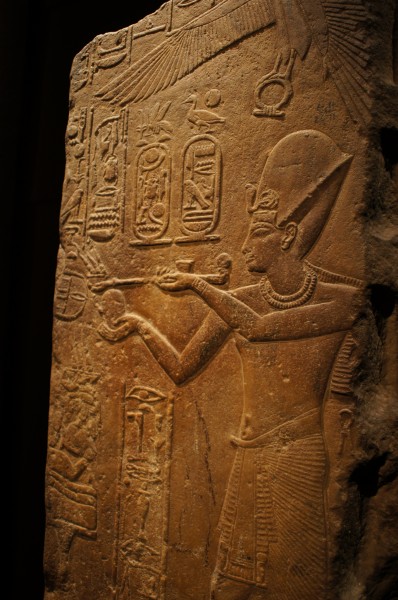
Relief of Horemheb
Horemheb was so dedicated to erasing the name and accomplishments of Akhenaten that he does not appear in any of Egypt's later historical records. Where he had to be cited it is only as "the heretic of Akhetaten" but never named and no reference made to his position as pharaoh.
DISCOVERY & PRESERVATION
The ruins of the city were first mapped and drawn in the 18th century CE by the French priest Claude Sicard. Other Europeans visited the site afterwards, and interest in the area was piqued after the discovery of the Amarna Letters. It was further explored and mapped in the late 19th century CE by Napoleon's corps of engineers during his Egyptian campaign, and this work attracted the attention of other archaeologists once the Rosetta Stone was deciphered and ancient Egyptian hieroglyphics could be read in c. 1824 CE. Akhenaten's name was therefore known but not his significance. It was not until archeologists in the early 20th century CE found the ruins Horemheb had dumped as fill that the story of Akhenaten was finally put together.
In the present day, the site is a wide, barren, expanse of ruined foundations which is being preserved and excavated by The Amarna Project. Unlike the ruins of Thebes or the village of Deir el-Medina, there is little left of Akhetaten for a visitor to admire. Egyptologist Steven Snape comments, "apart from the modest reconstructions of parts of the city by modern archaeologists, there is virtually nothing to be seen of the city of Amarna" (154). This is not unusual as the cities of Memphis and Per-Ramesses, both also capitals of ancient Egypt – as well as many others – are largely vacant lots today with far fewer monuments than those extant at Amarna.
What makes Amarna a special case in this regard is that the city was not leveled by time nor by an invading army but by the successor of the king who built it. At no other time in Egypt's ancient history was a city destroyed by a king's successor to blot out his name. To remove one's name from a temple or monument or tomb was to condemn them for eternity, but in this instance, only the removal of an entire city would satisfy Horemheb's sense of justice.
The Egyptians believed one had to be remembered by the living in order to continue one's eternal journey in the afterlife. In Akhenaten's case, it was not just a tomb or temple which was defaced but the totality of his life and reign. All of his monuments, in every city across Egypt, were torn down and every inscription bearing his name or that of his god was edited with chisels. Akhenaten's heresy was considered so serious, and the damage done to the country so severe, that he was thought to have earned the worst punishment that could be meted out in ancient Egypt: non-existence.
LICENSE:
Article based on information obtained from these sources:with permission from the Website Ancient History Encyclopedia
Content is available under License Creative Commons: Attribution-NonCommercial-ShareAlike 3.0 Unported. CC-BY-NC-SA License